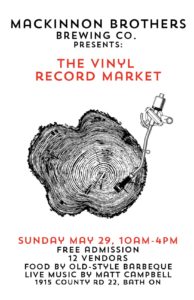 Here I am. Still on vacation but at least at home making dinners rather than forking out for them. Let’s be clear. I am not a cheap date when out and about but at the same time I do have my limits. Big city fun can hit that after a few days so nice to be back in the backyard for week two. Well, once the rain lets up. Gotta say, though, Montreal is my favorite big city even though I am maritally prohibited from rooting or the Habs. Drove past the front gate of the original and still operating Molson brewery established in 1786 when I got a bit lost in traffic coming into the downtown. Quite the edifice.
Here I am. Still on vacation but at least at home making dinners rather than forking out for them. Let’s be clear. I am not a cheap date when out and about but at the same time I do have my limits. Big city fun can hit that after a few days so nice to be back in the backyard for week two. Well, once the rain lets up. Gotta say, though, Montreal is my favorite big city even though I am maritally prohibited from rooting or the Habs. Drove past the front gate of the original and still operating Molson brewery established in 1786 when I got a bit lost in traffic coming into the downtown. Quite the edifice.
Speaking of working, on Wednesday Gary posted an image of a 1938 Quebec beer delivery truck out in winter. Looks like a display as those boxes look empty and stacked way too high. I cropped this image out of the right hand corner. I love the guy’s look. Button suspenders over a tucked in sweater, high lace leather boots, fedora and tie. And look at the window in the background. Signs – perhaps in neon – for Brasserie Frontenac, Boswell Cream Porter as well as Dow Old Stock Ale. These brands were all related to provincial firms that merged in 1909, the amalgamation which inspired a young E.P. Taylor two decades later to start off on his global merger mania. The truck and many of the boxes are also labeled with Dow’s Black Horse Ale. Cream Porter was still a thing when I lived in the Ottawa Valley in the mid-1990s under the Champlain brand made by Molson and in fact and early beer review on this here site was for Labatt Porter. Now there is a style that needs revival.
What else is going on? A few more ripples caused by the long piece in Pellicle on the state of IPA today are worth noting. JJB himself wrote positively of the explanation and agreed with how the code of IPA (as opposed to the definition) is effective for Stonch as a publican:
I can tell you that consumers with only a cursory knowledge of beer know what IPA means to them, and moreover that concept tends to be very similar across the board. When someone asks for an IPA, I know which taps to point them to.
Matt himself was unhappy with his thoughts being “torn apart in a @BeerAdvocate thread…” but that is a bit of an unfair statement as it was also praised there. His tension is reasonable.* There is a dismissal of old school thread writing but it is always good to remember that many there (folk who have no interest in blogging or certainly no interest in the dead end world of semi-pro beer writing) who know a hell of a lot about beer even though there are, yes, many oafs. For example, I entirely agree with this from someone on the site for fifteen years:
Once breweries realized that some of us were well and truly over the murkbombs, they started relabeling, or at least redescribing. It’s one of the reasons I’ve been shying away from any packaged beer called IPA unless I’m already familiar with it.
And also this from a seventeen year BA veteran:
It appears to me that the craft beer industry is viewing IPA = money and given this consideration I suspect that we will continue to see more and more beer brands with this labeling. They may be brands that can fit within one (or more?) of the categories that Matthew Curtis listed in his article or maybe they will be some brand-new name (e.g., New England style Wheat IPA) that some person just willy-nilly comes up with to make money.
Exactly. See, along with avoiding humour and any actual grasp of much of history, good beer culture has a very hard time with debate. It’s apparently uncomfortable for those trained on the short course who then have decided that they know what needs to be known, like a teen watching a movie with their parents when a dirty bit come on No, in craft beer culture it is a fundamental principal that you have to all sing from the same hymnal because it is all… great! That is why it generates no serious academic discourse – or even researched to and fro anymore. “Expert” is sorta of a participation award. Can you even call doing something “taking a course” if it fails to generate any deliverables that aren’t just repetition by rote? No, to discuss and disagree is rude. And that is one main reason why general good beer culture isn’t taken seriously.
Related perhaps, Ron summed up a trip to the USA and his observations on the beer scene this way:
I’m just back from the US. Wasn’t that impressed with the beer selection. Mostly: IPA, Sludge IPA, Sour Shit, Sour Shit with fruit, Sludge IPA with shit, Sludge IPA with fruit and shit, Pilsner.
Boak and Bailey unsettled me with a related consideration following up on a post from Jeff on the idea of session a few weeks back:
Jeff Alworth is right – most people (quite wisely) haven’t let themselves get bogged down in precisely what these terms mean. They just know that a brewery choosing to use a relatively more obscure word to describe its product is saying “You’re no rube, you know the lingo, welcome to the club.” As Matt points out, though, these terms are suffering the same fate as ‘craft beer’, becoming applied so widely, to products of such varying character, that consumers are beginning to distrust them. When you’ve decided you tend to like beers labelled IPA, and habitually order IPA, there’s only so many times you can be served something that doesn’t fit your mental model without getting irritated.
I am not sure what “quite wisely” is meant to suggest here. Basically, there isn’t much light between what is being said about the meaningless of craft beer’s terminology as code and Ron’s observations about how shit IPA has become due to the breakdown of meaning. Meaning it is no longer even code. You have to take a cartoon character approach to still suggest there is any integrity in all this. Which is what is being done, of course.
My thoughts? What’s the level below lowest common denominator? IPA might as well be “eBeer” or “iBeer” now. The meaninglessness has hit max and all it serves to do it shout “drink me, fool!” which is why I focus on the adjective and not the noun EEEPAH. And avoid anything like a flogged flavour wheel in favour of the theater of the mouth.** Fortunately, as we know, things have three names. In this case, there will be the name on the can or tap handle, the name the brewer uses and the name the beer knows itself by.
Which is perhaps why the lager boom is so attractive. It retains far more stylistic integrity that the botch US craft has made of the IPA everything concept. Paste magazine has gone so far as to say this is the best thing in the good beer world these days:
That’s the biggest thing that has changed, in the last few years—i.e., the pandemic era—ease of access to good craft lagers has increased exponentially, and breweries have seemingly gotten much better at making them! Even breweries not particularly known for lager are now frequently producing excellent examples, and I’ve seen a notable number of breweries also rebrand themselves to revolve more tightly around lager as a central philosophy.
One more thing. Stan picked up a thread from the IPA story, an actual fact about a yeast strain and unpacked it to explain how beers branded as Steam Beer do or at least did actually display a unique trait even though Steam Beer has little unique to do with steam:
In 1911, while conducting tests as part of another project at the University of California, T. Brailsford Robinson discovered just how different steam beer yeast acquired from California Brewing in San Francisco was from lager strains. “The yeast of the steam beer has accommodated itself to these conditions (warmer fermentation and the clarifier) to such an extent that it can no longer be employed for the preparation of lager beer, while lager-beer yeast may without difficulty be used for the manufacture of steam beer,” he wrote.
Neato. Also neato? Old lost Halifax Nova Scotia bars. Also neato? A Doctor Who based brewery. Less neato? The fall of certain people in the brewing trade that I know little about. Never been that much into the individual as a cornerstone to all of this, now that I think of it. Not neato? Possible signs of the market crashing.
For 22 years, Neal Stewart worked in sales and marketing for breweries like Pabst, Flying Dog, Mark Anthony Brands, Dogfish Head and Deschutes Brewery. He is leaving beer behind and left with some very powerful parting thoughts:
I had plenty of time to reflect on my time in the beer biz and quite honestly, it was a painful process. I discovered two things. First, my self-identity was wrapped far too tightly with my profession. My primary identity was my job. I wasn’t “Neal, the husband” or “Uncle Neal.” I was “Neal, the beer guy” or “Neal, the (insert one of the 47 breweries I’ve worked for) guy.” I was enamored with that identity and my ego needed it. Second, I really think I was addicted to stress. I’ve done some research and although “stress addiction” is not a clinical term, it is known that stress causes the brain to release cortisol and dopamine… When my life suddenly changed from 70 hours a week of non-stop calls, meetings and thinking about the business, to silence, I didn’t know how to react.
 Wow. If that is you, get out. What ever it is you do. And one more thing. I hadn’t expected that this beer would be as good as it turned out to be. Glutenburg Pale Ale out of Quebec. A bit of a rarer find in the Ontario LCBO but out there if you check the inventory. Made without barley but perfectly tasty as a base beer in one’s life. Which is what it might become. Through an odd sequence of absolutely low level medical matters it turns out that I may have a degree of gluten intolerance. See, I had to have a small four stitch operation on my right eyelid, which led to an observation about how my left eye sat, which led to a couple of CT scans in nearby quieter county town hospitals which led to an ENT guy sticking a camera into my sinuses, which led to connecting the dots to a very high wisdom tooth, which led to a removal operation, which led to me having a very tiny bit of my skull removed as a door for the wisdom tooth operation. All of which left me breathing better… unless I ate bread. Hmm. Bread made me puff up a bit. All over. Unpleasantly so on rare occasions. And feel like I had hay fever. Stuffed. So I dropped bread. Clearer head. Breathing better. Had a beer. All came back. Uh oh. So I bought this beer. Didn’t come back. Hmm. I had put the feeling when having a beer down to water bulking up or general alcohol reaction but it appears to be a third aspect of the beer – the gluten. Going to keep up the experiment for a bit. All of which I mention as ungraphically as I can as a recommendation to try it yourself for a week perhaps. See, being puffed is not good. Tiny important passages restrict. Blood pressure rises. Things not ticking along optimally. Leads to other things… more serious things.
Wow. If that is you, get out. What ever it is you do. And one more thing. I hadn’t expected that this beer would be as good as it turned out to be. Glutenburg Pale Ale out of Quebec. A bit of a rarer find in the Ontario LCBO but out there if you check the inventory. Made without barley but perfectly tasty as a base beer in one’s life. Which is what it might become. Through an odd sequence of absolutely low level medical matters it turns out that I may have a degree of gluten intolerance. See, I had to have a small four stitch operation on my right eyelid, which led to an observation about how my left eye sat, which led to a couple of CT scans in nearby quieter county town hospitals which led to an ENT guy sticking a camera into my sinuses, which led to connecting the dots to a very high wisdom tooth, which led to a removal operation, which led to me having a very tiny bit of my skull removed as a door for the wisdom tooth operation. All of which left me breathing better… unless I ate bread. Hmm. Bread made me puff up a bit. All over. Unpleasantly so on rare occasions. And feel like I had hay fever. Stuffed. So I dropped bread. Clearer head. Breathing better. Had a beer. All came back. Uh oh. So I bought this beer. Didn’t come back. Hmm. I had put the feeling when having a beer down to water bulking up or general alcohol reaction but it appears to be a third aspect of the beer – the gluten. Going to keep up the experiment for a bit. All of which I mention as ungraphically as I can as a recommendation to try it yourself for a week perhaps. See, being puffed is not good. Tiny important passages restrict. Blood pressure rises. Things not ticking along optimally. Leads to other things… more serious things.
There. The beery zeitgeist for another week has been summarized! Want more? Well, check out the updates from Boak and Bailey mostly every Saturday and perhaps now from Stan once in a while on a Monday. Check out the weekly Beer Ladies Podcast, and at the mostly weekly OCBG Podcast on Tuesdays or Wednesdays – and also sometimes, on a Friday, posts at The Fizz as well (Ed.: we are told ‘tis gone to podcast heaven… gone to the podcast farm to play with other puppies.) And the long standing Beervana podcast (Ed.: which I have missed from this list for some unknown reason.) There is a monthly sort of round up at The Glass. (Ed.: that seems to be dead now… nope, there was a post on July 25th… in 2022 even.) There is more from DaftAboutCraft‘s podcast, too. And sign up for Katie’s (Ed.: now very) irregular newsletter, The Gulp, too. And check out the Atlantic Canada Beer Blog‘s weekly roundup. Still gearing up, the recently revived All About Beer has introduced a podcast, too. (Ed.: give it a few weeks to settle in and not be as agreeable.) Plus follow the venerable Full Pint podcast. And Fermentation Radio with Emma Inch. The AfroBeerChick podcast as well! And also look at Brewsround and Cabin Fever. And Ben has his own podcast, Beer and Badword (Ed.: …notice of revival of which has been given… still not on the radio dial…) And remember BeerEdge, too, and The Moon Under Water. There has also been the Beer O’clock Show but that’s now wound up after ten years.
*I would not want to fail to mention Beth‘s similar sentiment: “I don’t have enough money to enter work for awards I don’t have enough money to fund my own press trips I don’t have enough money to buy a hundred samples to try I don’t have enough money for all the subscriptions or memberships How do writers do it? Actual question…” I may play a grump on social media but I am utterly sympathetic to the plight of the beer writer coming to the realization that for all the money in beer there is little money in beer.
**Make your own copy of the chart if you like. It’s also free and actually useful.

 Vacation? Haven’t had one of those since… 2019? Actually going places and looking at things? Don’t know how I will manage.
Vacation? Haven’t had one of those since… 2019? Actually going places and looking at things? Don’t know how I will manage. 

















